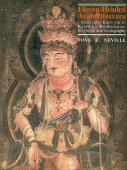Six Worlds, Six Realms: 1 definition
Introduction:
Six Worlds means something in Buddhism, Pali. If you want to know the exact meaning, history, etymology or English translation of this term then check out the descriptions on this page. Add your comment or reference to a book if you want to contribute to this summary article.
In Buddhism
General definition (in Buddhism)
Source: WikiPedia: BuddhismThe wheel [of the Bhavacakra] is divided into six sections which represent the Six realms (or Worlds) of Existence. These Six Worlds are:
- The World of Devas or Gods
- The World of Asuras (Tibetan: lha ma yin; Sanskrit: asura) (Demigods, Titans, Fighting Demons)
- The World of Humans
- The World of Animals
- The World of Pretas (hungry ghosts)
- The World of Hell
The World of Devas is always at the very top of the wheel. The World of Asuras and the World of Humans are always in the top half of the wheel, bordering the World of Devas on opposite sides, but which of the two is on the left and which is on the right varies (leading to two different arrangements of the wheel). The World of Animals and the World of Hungry Ghosts is always in the bottom half of the wheel, with the World of Animals bordering the World of Humans and the World of Hungry Ghosts bordering the World of Asuras. Between the World of Animals and the World of Hungry Ghosts, at the very bottom of the wheel, is the World of Hell.
Sometimes, the wheel is represented as only having five sections because the World of the Devas and the World of the Asuras are combined into a single world.
In Buddhist representations of the wheel, within each of the Six Realms, there is always at least one buddha or bodhisattva depicted, trying to help sentient beings find their way to nirvana (ibid).
See also (Relevant definitions)
Partial matches: Six.
Full-text (+17): Ahimsaloka, Sadgati, Shatgativartin, Ten Dharma Realms, Karyeshvara, Dharmabhaishajya, Karmabhoga, Jnanamaya, Karanesha, Mahasukha, Six Karmic Perceptions, Vivarnita, Traidhatu, Sarvabuddha, Sarvavastu, Sarvabhavaka, Pujita, Traidhatuka, Jnanabhoga, Dhatukatman.
Relevant text
Search found 32 books and stories containing Six Worlds, Six realms; (plurals include: Six Worldses, Six realmses). You can also click to the full overview containing English textual excerpts. Below are direct links for the most relevant articles:
The Great Chariot (by Longchenpa)
Part 3e.2b - The nirmanakayas who are tamers of beings < [B. The explanation of the kayas and wisdoms]
Part 4 - How beings are tormented in successive births within the six realms of beings < [A. The general explanation of the nature of suffering]
Part 2b - The suffering of wandering in samsara because of ego-grasping < [B. The extended explanation of the particulars]
The Dawn of the Dhamma (by Sucitto Bhikkhu)
Chapter 16 - What Kondanna Knew < [The Sutta]
Chapter 24 - Light In The World < [The Sutta]
Ksitigarbha Bodhisattva fundamental vow sutra (by Johnny Yu)
Chapter 11 - Earth Deities Protecting the Dharma
Chapter 2 - The Assembly of Innumerable Emanations of Ksitigarbha Bodhisattva
Bodhisattvacharyavatara (by Andreas Kretschmar)
Text Section 106 < [Khenpo Chöga’s Oral Explanations]
Text Section 119 < [Khenpo Chöga’s Oral Explanations]
Text Sections 165-166 < [Khenpo Chöga’s Oral Explanations]
Guhyagarbha Tantra (with Commentary) (by Gyurme Dorje)
Text 3.2 (Commentary) < [Chapter 3 (text and commentary)]
Text 3.1 (Commentary) < [Chapter 3 (text and commentary)]
Chapter 3 - The Establishment of All Dharmas < [Chapter 3 (text and commentary)]
Sūtra of the Great Vow of Kṣitigarbha Bodhisattva
Chapter 11 - The Earth Goddess Protects the Dhárma < [Scroll 2]
Chapter 2 - The Division Bodies Gather < [Scroll 1]
Chapter 9 - In Praise of of the Buddha's Name < [Scroll 2]
Related products
